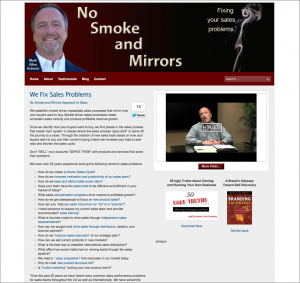Is Your Website Invisible to Buyers? Are you Sure?
The way buyers buy today is different than say 10 or even 5 years ago. Buyers use the internet and are highly educated on the products and services they buy. Most if not all companies have recognized this shift and the importance of having a web site and creating content that helps buyers buy. With as much as 60% of the buying process complete before a customer contacts your salespeople being found early in the buyer journey is no longer a nice to have but it is now critical. A number of companies’ web sites are invisible to buyers conducting internet searches because of what the industry refers to as “Mobilegeddon”.
Is your web site invisible? Are you Sure?
My friend David Barnhart recently wrote a post about “being Ghosted” in social media. Being ghosted is when someone deletes you from facebook, twitter and other social media and stops returning your emails. Basically you no longer exist and you are now a ghost to them.
David shares:
“When it happens to you personally, you feel hurt and confused. It’s a whole different problem when Google does it to your business website. Would Google do that? Well, yes. Here is a quote from Google’s blog:
“We will be expanding our use of mobile-friendliness as a ranking signal. This change will affect mobile searches in all languages worldwide and will have a significant impact in our search results.”
We call this mobilegeddon. Google is now evaluating your website for mobile usability if it finds mobile usability errors you will dins this message in your Google Webmaster Tools (now called Google Search Console) account:
Google systems have tested 135 pages from your site and found that 100% of them have critical mobile usability errors. The errors on these 135 pages severely affect how mobile users are able to experience your website. These pages will not be seen as mobile-friendly by Google Search, and will therefore be displayed and ranked appropriately for Smartphone users.”
Why is Mobilegeddon something that should concern every business owner, President, and CMO?
Google announced “more Google searches take place on mobile devices than on computers in 10 countries including the US and Japan.” I expect this will only increase so if your web site is not mobile friendly your site and all your valuable content is invisible to buyers you should be selling.
How do you know if your site is invisible? …take the quick test at https://www.google.com/webmasters/tools/mobile-friendly/ . It only takes a few seconds but will quickly let you know if your web site is invisible to buyers.
I have been hearing about this and finally went to the site and tested my blog at the google test site above and was shocked to find my site was invisible. I have been writing since 2005 and now all my content on fixing sales problems and how to create sales velocity is invisible? It looked like this:
So I called my friend David at Business Blogging Pro’s. David knows how to make web sites mobile friendly and originally designed my blog. He taught me how to use my blog and has coached me on content and blogging for years. I have sent a number of clients to David when they wanted to create blogs to establish thought leadership in their industries and drive traffic to their web sites. Within just under a week David redesigned my site and now it looks as it does today.
Is your web site Invisible?
Can buyers find your company in Google searches today?
Can you afford not to have your web site found today?
If you agree that more web searches are being done on mobile devices than desktops and as much as 60% of the buying journey is completed before buyers contact you…you must make sure your web site is mobile friendly. If you are like me, you understand the importance of this but find your web site is invisible, I highly recommend you hire an expert to make your web site mobile friendly.






